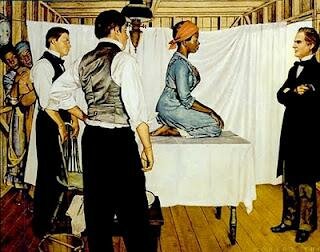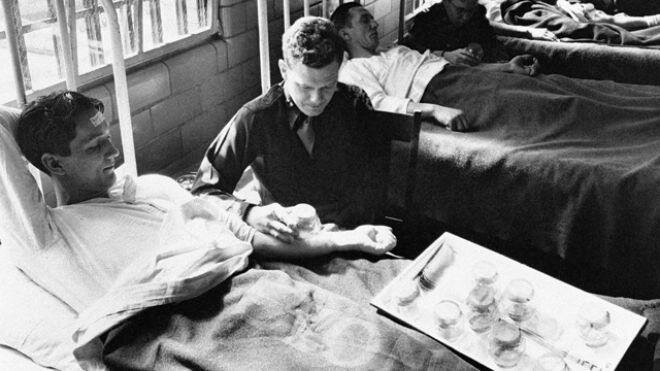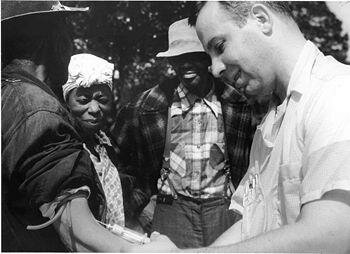Top 10 Minority Medical Experiments
Suggested by SMSThroughout the history of the world, here have been moments where medical professionals have simply gone too far. With hopes of medical advancements, they have shown blatant disregard for human life. Instead of curing the ill, they have often been the source of disease.
10. Random Vaccination Experiments in Medical History
Throughout history there have been multiple instances of experimentation involving vaccinations and minorities. With so many too list, here is just a few that stand out:
- In 1896, Dr. Arthur Wentworth uses 29 patients at Boston’s Children’s Hospital to perform spinal taps. His reason: he wanted to test whether or not the procedure was harmless.
- In 1913, 15 children at a children’s home in Philadelphia are “tested” with tuberculin. As a result, some of the children become blind.
- In 1915, Dr. Joseph Goldberger follows order of the U.S. Public Health office and produces large quantities of Pellagara. He then infects 12 Mississippi inmates with the nerve damaging disease in an effort to find a cure.
9. The Filipino Experiment of the 1900’s
This little known experiment has no true given name. This may be due to the fact that it wasn’t large scale or was merely the work of a single doctor, who was out to prove something. Either way, it was just an unethical as any other medical experiment that used humans as lab rats. Even on a scale of this level, it caused a loss of human life.
In 1900, a group of American doctors were in the Philippines. During their stay, they chose five prisoners to infect with the bubonic plague. In addition, they infected another 29 prisoners with beriberi. Of the 29 that were infected, four died.
Six years later, professor by the name of Richard Strong (Harvard University), infected 24 prisoners with cholera. This strain of the disease has somehow become tainted with the bubonic plague. His experiment was intentional and was conducted without the consent or knowledge of his subjects. As a result, all of his subjects fell ill and 13 of the 24 succumbed to the diseases.
8. Forced Sterilization
Also known as “compulsory sterilization”, the Unites States of America was the first country to implement a program of this nature in an effort to control the population of certain races. The program primarily targeted those afflicted with mental illnesses, the visually and hearing impaired, individuals suffering from leprosy and those with physical deformities. It was also a belief that Native and African American women were often sterilized, unbeknownst to them, during periods of hospitalization. There were instances of sterilizations being performed in penal institutions.
In 1897, Michigan became the first state to introduce a forced sterilization bill. It didn’t get enough votes to pass. In 1905, a similar bill was passed in the state of Pennsylvania but it was vetoed. Four years later, Indiana became the first state to enact a compulsory sterilization bill. Many states followed. The last forced sterilization was took place on 1981. By the end of it all, more than 65,000 people were forcibly sterilized in 33 states under this inhumane program that was initiated by the United States of America.
7. The Gynecological Work of J. Marion Sims
James Marion Sims is heralded as a groundbreaking surgeon. Many refer to him as the father of American gynecology. However, some don’t believe that he should be warranted with such prestigious titles because he utilized slaves as subjects for his experiments.
In 1845, Dr. Sims established a private hospital for women in Alabama. Here, he would perform multiple experimental surgeries. The first was to repair a vesicovaginal fistulas; which is normally associated with hard labor. In that day and age, women who suffered from this condition were considered socially inadequate.
Sims performed experimental surgery on three slave women who suffered from the condition. He did so in an effort to develop improved methods and for medical research. He operated on the women for 5 years without the use of anesthesia. One woman was operated on at least 30 times. He perfected his techniques by experimenting on slave women. It was only then that he would perform the reparative surgery on Caucasian women, with the use of anesthesia.
Dr. Sims’ experimental surgeries made the way for modern vaginal surgeries. He is man that devised the gynecological instrument known as the speculum. The position that patients are placed in during a rectal examination is also named after him. In 1852, it was reported that his suture technique with silver-wire resulted in the successful repair of a fistula.
6. The Stateville Penitentiary Malaria Study
This controlled study of malaria was conducted prisoners of Stateville Penitentiary in Illinois during the 1940’s. The study was the work of the U.S. Army, in conjunction with the University of Chicago’s Department of Medicine. It had a great impact on the Nuremberg Medical Trial and led to more medical experiments that were conducted n prisoners.
During WWII, the efforts of U.S. military were halted by malaria and other diseases that they were afflicted with during battle. As a result, the military felt the need for human experimentation in order to test new drug treatments. The prison system was thought to be ideal.
The research was performed on a single floor of the prison hospital. The goal was to gather information on the effectiveness of different drugs in cases of relapse. This was the first human, anti-malarial drug testing to ever be conducted. Mosquitoes were bred and infected with malaria just for this research study.
Single patients were bitten by 10 infected insects. 441 participants were volunteers. Only one patient died during the study, and it’s believed that he died of a heart attack. Malaria research was conducted at the prison for a total of 29 years. Well known murderer, Nathan Leopold, was a participant in the study.
5. Unit 731
Unit 731 was a secret unit of the Imperial Japanese Army that conducted biological and chemical warfare studies. The army began using human experimentation during the 2nd Sino-Japanese War and WWII. The unit was formally known as the Epidemic Prevention and Water Purification Department of the Kwantung Army. The unit was snatched out of the hands of the Kempeitai military police and commanded by General Shiro Ishii until the end of the war.
As part of the medical experimentation, prisoners were intentionally infected with diseases; although they believed that they were being vaccinated. The research was being in an effort to track what would happen when a venereal disease is left untreated. The diseases of choice were syphilis and gonorrhea. Some prisoners were also deliberately infested with fleas so that doctors could gather large amounts of disease ridden fleas. The fleas would be studied to test their effectiveness in germ warfare.
4. Rockefeller Institute for Medical Research (1911)
As part of the Rockefeller Institute for Medical Research, in 1911, Dr. Hideyo Noguchi discovered the agent of syphilis as a root of progressive paralytic disease. A well-known bacteriologist, he infected 146 patients with the horrible disease. Some of the patients that were injected were children. In 1913, he was able to prove his finding when he demonstrated the existence of the agent in the brain of a patient with progressive paralysis.
He would subsequently be sued by the parents of the children that were believed to have contracted the disease from his experiment.
3. Medical Experiments at Auschwitz
During the Holocaust, people of Jewish heritage were tortured and massacred. They were also victims of cruel medical experiments that only magnified the criminal acts that were already being conducted against them. Although the concentration camps were filled with horror, there was none that compared to Auschwitz. The medical experiments that were conducted there, sans anesthesia, were like no other. The doctors responsible for them will forever be known as medical criminals.
A professor and doctor by the name of Carl Clauberg decided that sterilization would be the area in which he experimented. With a large area available to him and his “research”, the doctor created a non-surgical method of mass sterilization. In this method, he would inject the female reproductive organs with a chemical solution that would induce severe inflammation. A few weeks after the irritant was introduced to the body, the fallopian tubes of would become blocked. Some of the women that were subjected to this treatment died as a result. Others were killed in order to perform autopsies.
Another physician, Dr. Host Schumann, also experimented with mass sterilization. His goal was to enable the biological destruction of other races. This doctor chose to use a method referred to as “X-ray sterilization”. The ovaries and testes of Jewish men and women would be exposed to extreme doses of radiation. This would often result in critical burns to certain regions of the subjects’ bodies. However, he doctor was not happy with the results of his experiment.
Between the years 1941-1944, some physicians deliberately infected prisoners with contagious diseases in order to test the effectiveness and tolerance of new medications. There were also medical studies that were performed to track the effects of starvation.
2. Guatemalan STD Experiment
In an uncanny resemblance to the horrible Tuskegee Syphilis Experiment, the United States government used the disease in another human study between 1946 and 1948. During that 2 year span, Guatemalan health officials worked with American political heads to study the disease. American doctors injected the disease into soldiers, hookers, prisoners and mental health patients. Just as before, the subjects were unaware of the experiment. However, this time around, antibiotics were used. Unfortunately, at least 83 subjects lost their lives during the study.
The Guatemalan experiment was spearheaded by U.S. Public Health Service physician, John Charles Cutler. Ironically, he was also one of the doctors that played a role in the latter parts of the Tuskegee syphilis experiment. Research papers would later show that the U.S. Surgeon General, Dr. Thomas Parran Jr., felt it was necessary to keep the details of the study hidden from the health officials of Guatemala.
Funding for the project was provided through a grant from the National Institute Health of the Pan American Sanitary Bureau. There has never been any proof but it’s believed that approximately 1500 subjects to par in the study. Most of the information pertaining to the study was discovered by Professor Susan Reverby in 2005, as she researched the Tuskegee study. She shared what she found in Cutler’s archived papers with the United States government.
The Tuskegee study was conducted to track the natural progression of the disease in men who were already afflicted with the illness. In Guatemala, the goal was to infect healthy participants and determine how effective penicillin was a preventative measure and a treatment for venereal diseases. Prostitutes that were infected were monetarily compensated to have sex with people; while others were given the disease directly. Once a person contracted the disease, they were treated with the antibiotic.
The study came to an end in 1948, when rumors and gossip brought attention to it. However, many patients were observed until some period of the early 1950’s. In 2010, the Unites states government offered a formal apology to Guatemalans, calling the unethical experiment a “crime against humanity”.
1. Tuskegee Syphilis Experiment
The Tuskegee Syphilis Experiment is undoubtedly the most well known minority medical experiment to ever be conducted in the history of the Unites States of America. Initiated in 1932, the study was allegedly conducted to track the natural progression of the disease in poor black men. The men who participated in the study were under the impression that they were part of a government program that was providing free healthcare.
In 1932, the government enrolled 600 poor, sharecroppers from Macon County, Alabama into the study. Of the total number, 399 had contracted the disease prior to beginning of the study. The remaining 201 were healthy. As an incentive for their participation, the men were offered free health care, free meals and ironically, free burial insurance policies. Unfortunately, they were never informed of the fact that they had the disease. They were also never treated for it. The only thing that the participants were told was that they had “bad blood”. At the time, that term was used to imply a number of afflictions; including anemia and fatigue.
The study was conducted for 40 years. It was considered controversial by many due to its unethical standards. Aside from the moral standpoint, the failure to treat the participants once penicillin was validated as a cure was immoral. By 1947, doctors were still choosing not to treat the participants or inform them f the fact that there was a cure available to them. Participants were also hindered from accessing public information in regards to syphilis and the treatments for it, in order to continue their study. The study ended in 1972, when an accidental leak to the press caused the government to pull the plug.
Needless to say, the men that participated in the study suffered from the many side effects of the disease. Of course, some of them lost their lives.
As you can see, some stories are longer than others and some may seem more horrid than others. No matter how disturbing, the disregard for human life that medical professionals sometimes show is always heartbreaking



















